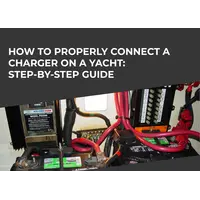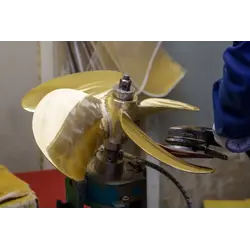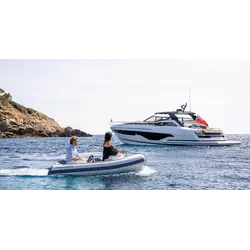The selection of mooring lines, safety lines, sheets, towing and mast lines is an important part of the rigging stage of any vessel. Indeed, the reliability of fastening the vessel to the berth, mooring poles and the long service life of the running rigging depend on the correctness of such choices.
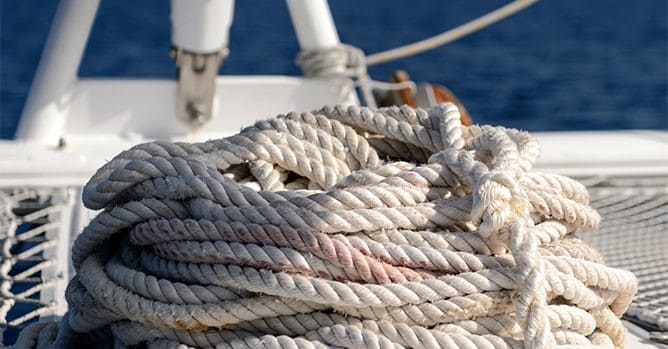
When to Clean the Rope
Modern ropes are more versatile, but there is still enough trouble with them, and one of the main problems is rope care, storage conditions and cleaning. With constant use, dirt and bottom silt stick to the ropes, sea salt crystallizes, algae and microorganisms decide that it’s their home now. All this has a rather negative effect on the strength of the fibers and reduces the service life of ropes or cables.
In general, the level of pollution can be divided into three stages:
- Nightmare, such dirty ropes!
- Well... Still bearable.
- No need to clean the rope for now.
Special tools: Ropecleaner
When there is no time for soaking and other procedures, and the mooring line is covered with a crust of adhering clay and salt, then a rather interesting device for mechanical cleaning comes to the rescue.
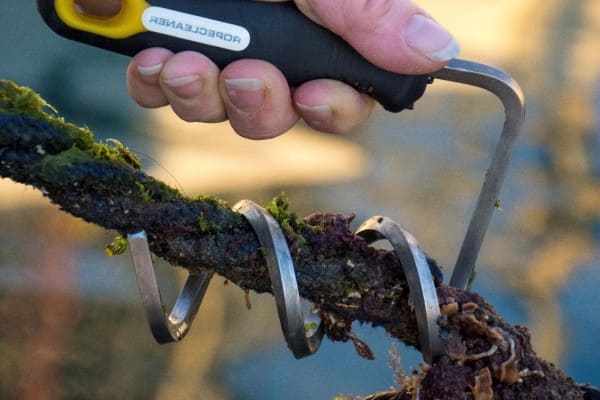
This is Boatasy Ropecleaner - a strong metal spiral 6 mm in cross section and 32 mm in internal diameter, mounted on the handle, which allows you to quickly clean off the accumulated layers of algae, shells, dirt and is suitable for ropes of any section and thickness.
The internal sharpened edges of the spiral cut the adhering crust, and thanks to the design of the device, debris, ice and other growths fall back into the water. In ten minutes, you can clean several ten-meter cables or a mooring line of 30 meters (98.4 feet). This is convenient because the device can be stored in a locker and is always at hand unlike water jet cleaners, divers or the hassle of dry cleaning, and it obviously does not require connection to the circuit.
But, unfortunately, such devices only clean the outer layer and cannot protect the fibers from constant exposure to sunlight, sea salt and temperature extremes. This is especially true of ordinary halyards, which are permanently attached to the mast, they are constantly exposed to ultraviolet radiation and rarely desalinated. In a couple of years, the strength of such ropes can drop very much, and if you often have to climb the mast, then the toprik.com team strongly recommends using a safety line and being careful about your own safety.
In order for cables and halyards to wear out less, serve for a long time and not fail at a crucial moment, they must be looked after, reasonably approached for storage and drying, and most importantly, they must be periodically washed and desalinated. In the next section of the article, we will consider the recommendations of manufacturers, as well as the private experience of crews and shipowners.
Machine Wash
Let's start with the fact that new, just purchased ropes should not be seriously washed at all. It will almost certainly make things worse because manufacturers, when making ropes of modern polypropylene and polyester cables, treat the core fibers and sheaths with substances and lubricants in the process so that the ropes can better withstand the aggressive marine environment and exposure to sunlight. Many cleaning products contain alkaline and degreasing compounds that dissolve the impregnation and can damage synthetic fibers.
Serious cleaning with a washing machine, powder and chemical cleaners is more suitable for ropes with stubborn dirt that have served for a couple of years and are a little frayed, as a result of which they collect the salt inside quickly and deeply. Fortunately, modern polyester ropes are not at all afraid of algae and microorganisms, but you still have to clean it for aesthetic reasons, and in order not to injure your hand on adhering shells.
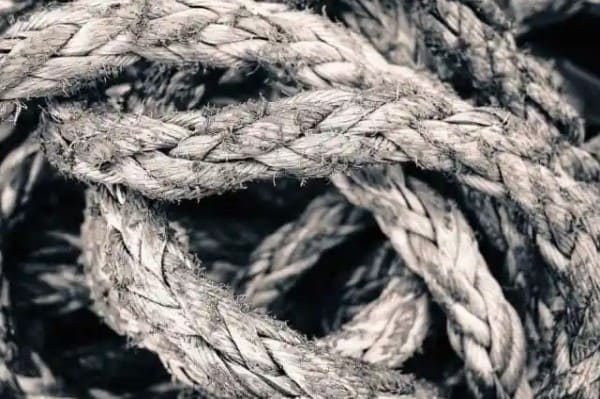
The companies are recommending the most discreet measures for new halyards, like soaking and rinsing in lukewarm fresh water and nothing more, and they seem to be right. Manufacturers are more focused on drying after cleaning because it is not a good idea to dry synthetic ropes in the sun while they are still coiled.
After washing, the rope is limp, saturated with water, and if it is wound into a coil and hung to dry in this form, the rope will stiffen a little in this position – in some place the segment will be semicircular, and in some others flattened. It is very frustrating to work with such a rope, especially if it is part of the running rigging or if you have to use blocks, winches and descenders. Also, do not hang wet twists on metal pins or hooks. The rust that forms on the pins corrodes and damages the ropes. Therefore, for drying, it is better to lay out the halyard in rings or loops on the floor of a ventilated room and let it dry well.
Sometimes you can see a strange picture of drying ropes on the life lines during a voyage, moreover, during the discussion it turns out that the owners are well aware of the harm done to ropes by salt and ultraviolet radiation. If wetted with salt water, then dried in the sun many times over, it ages and wears out the rope very quickly, and such owners simply prefer to pay for a new cable and have no claims against the manufacturers. The same sailors who treat rigging and mooring lines more carefully gave us a number of tips on care and storage:
- coil the ropes and hide them from the sun;
- store them in a dry dark place;
- do not leave ropes in the water;
- regularly desalinate the ropes;
- avoid contact with chemicals;
- check for damage;
- untie the knots and do not step on the halyards.
Following these recommendations significantly extends the service life, and most importantly, the reliability of gear. A torn cable at a critical moment can cause some trouble, to put it mildly.
But back to cleaning. Due to the fact that ship ropes have to perform different functions, their design is also different. For example, for mooring and tying a yacht to the pontoon, it is customary to use twisted ropes, and for setting and controlling sails, the majority prefers to use braided synthetic cables, whereas floating polypropylene ropes are used to rescue drowning people. They also get dirty and damaged in different ways, because the same mooring line can be covered with a thick layer of silt, ice or shells in addition to salt crystals.
Such ropes are more like a stick even in appearance, and we strongly advise against trying to put this in a washing machine. During general cleaning or preparation for a long stay, it is worth pre-sorting the ropes according to the degree of filthiness, and especially neglected cases are best subjected to primary surface mechanical cleaning with a brush and soaking in a container with warm fresh water - it can be a technical bath, a large basin or a bucket. You can add soap shavings, gentle detergents or a special shampoo for ropes (yes, there is such a product). Pre-cleaning with water jets creates the risk of damaging the fibers or even cutting through the braid with a high-pressure jet of water, so be careful with that.
Do not expect to wash the ropes to pristine purity, this is a utopia! Manufacturers regularly complain that they constantly receive reports of damaged or melted ropes due to various bleaches and harsh cleaners.
After the initial treatment and soaking in warm fresh water, it is sometimes worth moving the rope in the container, and in especially sad cases, change the water and carry out the procedure a couple of times - after that you need to let the rope dry and then it's time for the washing machine, if it is still necessary.
It must be said that the inept washing of the ropes destroyed as many washing machines as it destroyed the ropes. Please note that many top-loading or front-loading household washing appliances have a certain weight limit, you should not overload it and focus only on the available amount of free space inside the drum.
Before loading, wind the rope into a tight twist so that the rope does not get tangled during washing, you can also put it inside a net or pillowcase - this will further reduce the risks of winding onto the drum, and you will not end up with Gordian knot inside the machine. It is advised to use only low-intensity washing and avoid detergents and powders, if possible, unless you are one hundred percent sure of them.
Separately, it is necessary to mention nylon ropes, they are absolutely unpretentious in matters of purification. It is much easier to remove dirt from synthetic fibers than from natural materials.
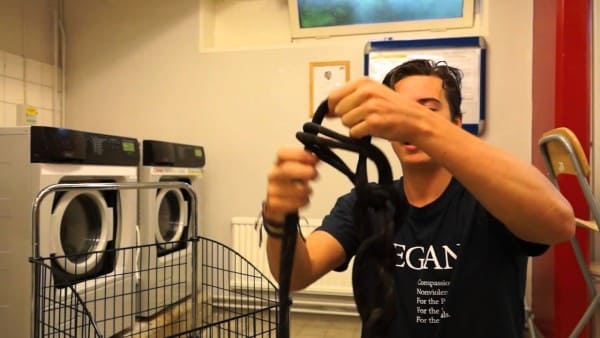
Here are a few recommendations from experienced users:
- use a slow, gentle wash;
- the temperature should not exceed 30 degrees;
- do not use chlorine bleaches and aggressive powders;
- prolonged soaking should be avoided;
- soap and dirt residues are rinsed out using a large volume of water;
- you can squeeze lightly or wait until the excess moisture drains on its own.
Nylon is very vulnerable to alkalis and acids - prolonged soaking with highly alkaline detergents and especially acid cleaners can significantly weaken the rope, making it practically unsuitable for serious loads.
To summarize, a thoughtful and careful approach will save you from many troubles and problems associated with cleaning ropes and desalinating halyards. And fortunately, this is not something that yachtsmen have to do almost every day (unlike cleaning the boat). Usually on a boat it all comes down to coiling and occasional washing with fresh water - you only have to devote a lot of time to cleaning before wintering or long-term docking.
If you follow these simple tips, your ropes will not let you down at a crucial moment and will serve effectively and for a long time.




